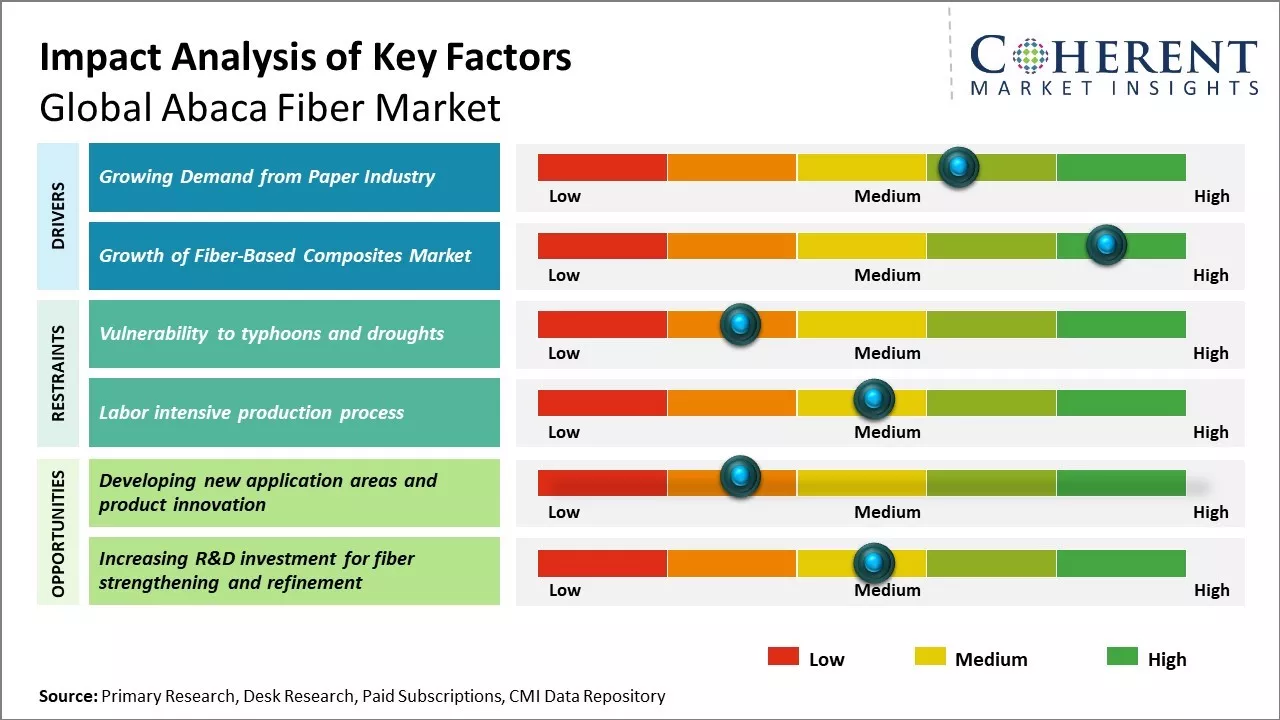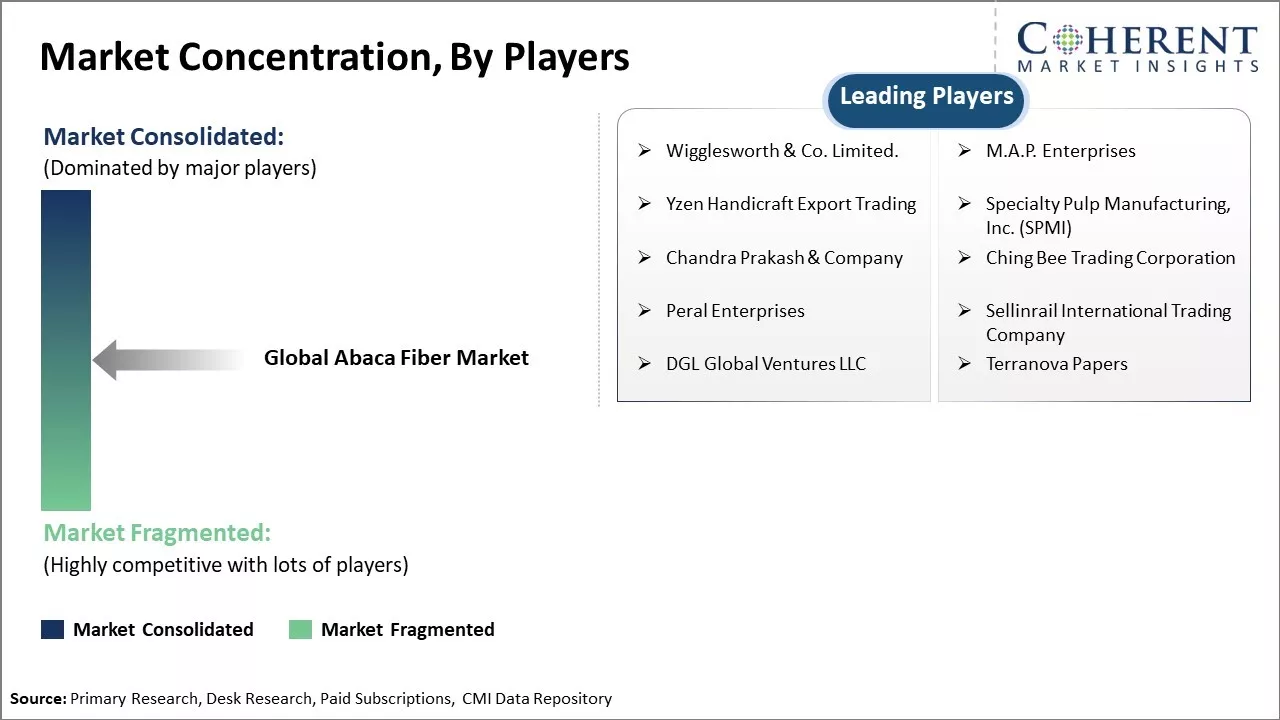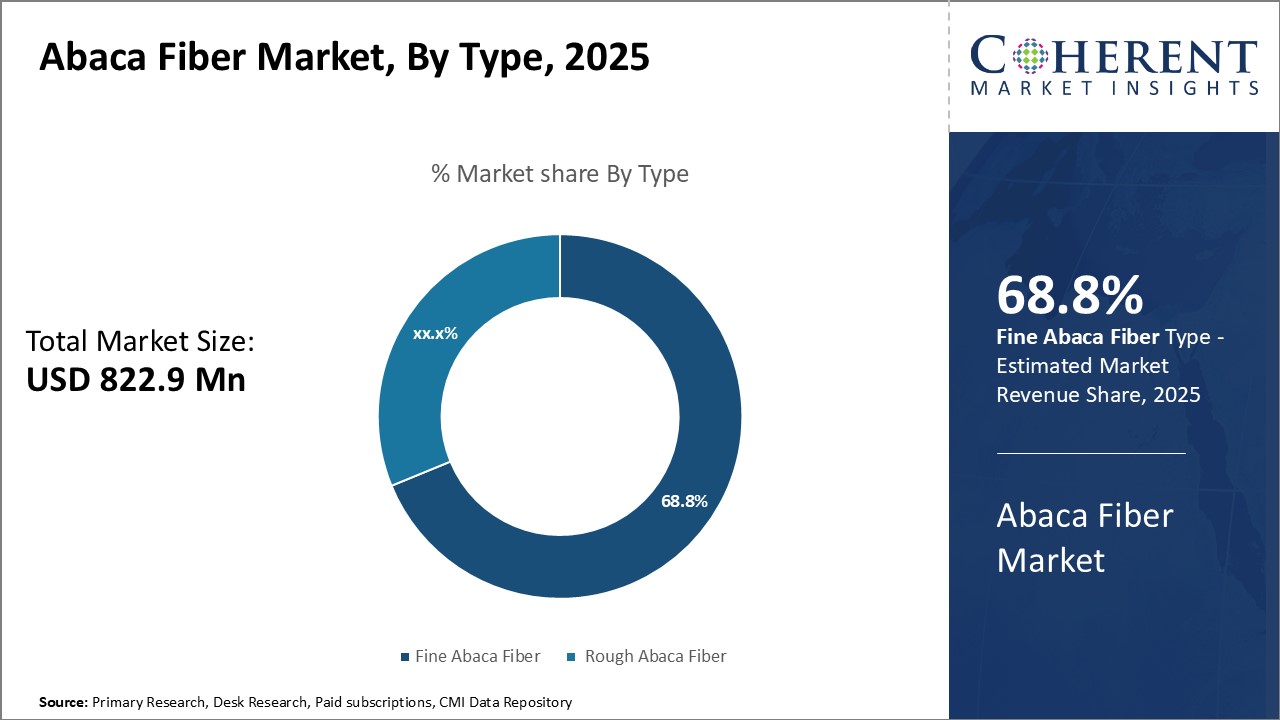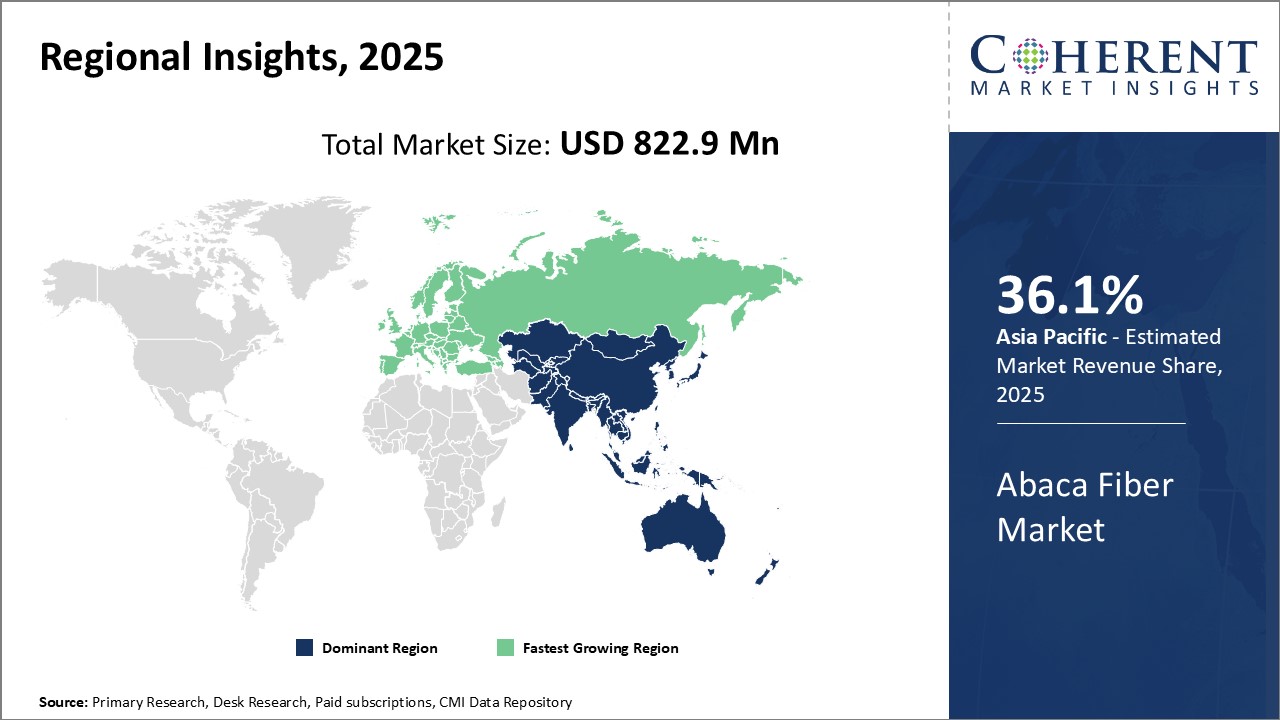Abaca Fiber Market Size and Trends
The Abaca Fiber Market is estimated to be valued at USD 822.9 Mn in 2025 and is expected to reach USD 2,244.1 Mn by 2032, exhibiting a compound annual growth rate (CAGR) of 15.4% from 2025 to 2032.

Discover market dynamics shaping the industry: Download Free Sample
Abaca fiber is majorly used in the production of industrial fabric and household decoration items. Its high tensile strength and flexibility makes it a suitable substitute for fiber crops like jute and sisal in various industrial applications. The market growth is driven by increasing demand from paper industry for manufacturing high quality writing and printing paper. Abaca fiber finds extensive usage in manufacturing ropes due to properties like high durability against seawater and rotting. The development of novel application areas such as technical textiles and non-woven materials will provide growth opportunities for abaca fiber producers.
Growing Demand from Paper Industry
The demand for abaca fiber is on the rise from the paper industry across the globe. Abaca fiber offers several advantages over wood pulp which is commonly used in paper manufacturing. It has higher wet strength compared to wood pulp which allows the paper manufactured using abaca to withstand moisture better. Hence, it is being increasingly used in production of banknotes, currency paper and other specialty papers. Banknotes manufactured from abaca paper last longer compared to conventional paper notes and don't get easily torn. Additionally, filtration and cigarette paper require higher wet strength which abaca fulfills very well. Abaca fiber provides smooth surface and superior printability to paper. The papers manufactured using abaca take ink very well and provides sharp images and prints. This property has increased its usage in printing and publishing industry. Magazines, brochures and catalogs are now adopting abaca paper to provide best print quality to readers. Abaca fiber also provides good opacity to paper allowing both sides of paper to be used for printing. Manufacturers are able to optimize paper usage and reduce wastage by utilizing both sides for printing output.
Market Concentration and Competitive Landscape

Get actionable strategies to beat competition: Download Free Sample
Growth of Fiber-Based Composites MarketAnother key driver propelling abaca fiber demand is expanding market for fiber-based composite materials. Fiber composites are becoming increasingly popular substitute for wood, plastic and other materials in variety of end-use industries. Abaca fiber exhibits valuable mechanical properties including high tensile strength, making it suitable reinforcement for composites. Composites reinforced with abaca fiber demonstrate better mechanical strength compared to other natural fibers like coir, sisal and bagasse. Its flexural properties allow fabrication of lightweight and impact resistance composites.
Key Takeaways of Analyst:
The abaca fiber market shows promising growth potential over the next few years. Demand for abaca fiber is expected to steadily increase from the pulp and paper industry as it is highly sustainable and eco-friendly in nature. Asia Pacific currently dominates the market owing to the large abaca plantations in the Philippines, which is the largest producer and exporter of abaca fiber globally. Countries like China, India, and Indonesia also offer ample opportunities for abaca fiber suppliers and manufacturers.
Abaca fiber provides high tensile strength and durability. This makes it suitable for manufacturing products ranging from automobile and aircraft components to construction materials. Rising environmental consciousness is compelling manufacturers to adopt natural fibers over synthetic alternatives. Abaca fiber possesses properties that make it advantageous over glass fiber for certain end-use industries.
The market may face restraints from fluctuations in abaca crop yields and prices due to changes in climatic conditions and soil fertility. High dependence on rain-fed cultivation also poses risks. Lack of advanced processing technologies in major abaca producing countries can hinder capacity utilization. Nevertheless, continuous R&D focused on improving abaca varieties and cultivation methods would help boost overall supplies.
Market Challenges: Vulnerability to typhoons and droughts
Vulnerability to natural calamities is a major challenge restraining the growth of global Abaca fiber market. Abaca fiber, also known as manila hemp, is primarily grown in the Philippines. The Philippines is one of the most disaster-prone countries in the world, situated on the Pacific Ring of Fire. It faces frequent typhoons and droughts which adversely impact abaca cultivation. Abaca plants are highly susceptible to typhoons and heavy rainfall. Strong winds during typhoons can flatten entire abaca plantations. Also, excessive rainfall and floods cause root rot diseases in abaca plants. As per data by the Philippine Statistics Authority, in 2020, typhoons Goni and Vamco destroyed over 5000 hectares of abaca farms in Quezon province alone. Similarly, the 2015-2016 El Nino induced drought ravaged abaca crops in Southern Luzon and Western Visayas regions. Over 15,000 farmers had to stop abaca cultivation temporarily due to drought as per the Department of Agriculture, Philippines report.
Market Opportunities: Developing new application areas and product innovation
Developing new application areas and product innovation could provide significant opportunities for growth in the global abaca fiber market. Abaca fiber is renowned for its robust and durable nature making it suitable for a variety of applications beyond its conventional use in rope and twine products. The fiber is now being explored for its use in specialty paper applications due to its high tear and burst strength. Several research studies have shown that abaca fiber when blended with wood pulp can enhance the paper qualities. This allows for production of high-quality printing and writing paper with abaca fiber. As concerns over environmental sustainability increase, demand for papers with higher fiber content is expected to rise providing a boost to abaca fiber incorporation in the paper industry.

Discover high revenue pocket segments and roadmap to it: Download Free Sample
Insights, by type: Fine Abaca Fiber holds the highest share of the market owing to its wide applicability and premium qualityFine abaca fiber is estimated to hold 68.8% share in the type segment of the abaca fiber market in 2025, due to its premium quality and wide range of applications. Fine abaca fiber is refined and processed to achieve very high tensile strength and fineness, making it suitable for high-end applications. Its fine texture and luster make it an ideal replacement for cotton and other fibers in superior quality textiles. The attractive appearance and naturally greenish color of fine abaca fiber are appreciated by textile manufacturers and consumers. Fine abaca fiber is predominantly used in the production of high-quality clothing fabric, ceremonial dresses, and apparel with embroidery or embellishments that require a soft, delicate, and aesthetically appealing texture. It is also utilized in technical textiles, safety gear, military uniforms, and specialty clothes meant for harsh working environments due to its durable nature. The fiber finds application in geotextiles and other civil engineering projects as well owing to its resistance to moisture, decay, and inherent strength. Thus, the exceptional and versatile properties of fine abaca fiber have enabled it to dominate the type segment.
Insights, by application: Textile holds the highest share of the market driven by widespread usage in apparel and home textiles
Textiles is estimated to account for 36.1% share of the application segment in the abaca fiber market in 2025. Abaca fiber has been an important raw material for textile manufacturing due to its desirable attributes. The fiber's breathable yet durable characteristics have made it highly suitable for clothing and other fabrics used near the skin. Its moisture-wicking, antimicrobial, ultraviolet-resistant, and insulating properties provide thermal comfort even in wet and humid conditions. The textile industry extensively uses abaca fiber for various types of apparel like shirts, dresses, uniforms, and accessories that need to be lightweight, strong as well as sweat-absorbent. Home textiles like curtains, upholstery fabrics, and mattress stuffing are another major application area. Abaca fiber's ability to add elegant drape and texture to textile products without stretching or shrinking has boosted its popularity among manufacturers. The COVID-19 pandemic has further augmented demand for comfortable work-from-home and loungewear made from breathable abaca fabrics. Thus, the universally adaptable nature and performance benefits of abaca fiber have fueled its widespread use in the textiles sector.
Regional Insights

Need a Different Region or Segment? Download Free Sample
The global abaca fiber market is experiencing significant growth, with various regions contributing to its expansion. As of 2025, the Asia Pacific region is estimated to emerge as the dominant market for abaca fiber, accounting for approximately 36.1% of the total market share. On the other hand, Europe has been identified as the fastest growing region in terms of abaca fiber consumption and production. The Asia Pacific region has long been a key contributor to the abaca fiber market. Countries such as the Philippines, Indonesia, and Papua New Guinea are major producers of abaca fiber in this region. The favorable climatic conditions, abundant availability of abaca plantations, and skilled labor force have propelled the growth of the abaca fiber industry in this region. The Philippines, in particular, holds a dominant position in the global abaca fiber market, owing to its extensive abaca cultivation and well-established processing infrastructure. The country has a rich history of abaca fiber production and has been supplying to various industries, including textile, paper, cordage, and specialty paper industries.
Europe has emerged as the fastest growing region in the abaca fiber market. The increasing awareness about the environmental benefits of using natural fibers and the rising demand for sustainable and eco-friendly materials have stimulated the growth of the abaca fiber industry in this region. Countries like Germany, France, and the U.K. have witnessed a surge in the adoption of abaca fiber across various sectors. The use of abaca fiber in the automotive industry for manufacturing lightweight and eco-friendly components has gained significant traction. Additionally, the construction and packaging sectors in Europe have also shown an increased preference for abaca fiber due to its strength, durability, and biodegradability. Furthermore, government initiatives promoting the use of natural fibers and sustainable materials have provided a boost to the abaca fiber market in Europe. Stringent regulations and policies aimed at reducing carbon emissions and promoting the circular economy have further propelled the demand for abaca fiber in the region.
Market Report Scope
Abaca Fiber Market Report Coverage
| Report Coverage | Details | ||
|---|---|---|---|
| Base Year: | 2024 | Market Size in 2025: | USD 822.9 Mn |
| Historical Data for: | 2020 To 2024 | Forecast Period: | 2025 To 2032 |
| Forecast Period 2025 to 2032 CAGR: | 15.4% | 2032 Value Projection: | USD 2,244.1 Mn |
| Geographies covered: |
|
||
| Segments covered: |
|
||
| Companies covered: |
Wigglesworth & Co. Limited., M.A.P. Enterprises, Yzen Handicraft Export Trading, Specialty Pulp Manufacturing, Inc. (SPMI), Chandra Prakash & Company, Ching Bee Trading Corporation, Peral Enterprises, Sellinrail International Trading Company, DGL Global Ventures LLC, and Terranova Papers |
||
| Growth Drivers: |
|
||
| Restraints & Challenges: |
|
||
Uncover macros and micros vetted on 75+ parameters: Get instant access to report
Abaca Fiber Industry News
- In November 2023, Advantive acquired Abaca Systems, a packaging software solutions company based in Manchester, England. The acquisition expands Advantive's expertise in packaging and corrugated space for European markets.
- In November 2022, Safe Harbor Financial (SHFS) acquired Rockview Digital Solutions, Inc., also known as Abaca, a financial technology platform for the cannabis industry.
- The Abaca Project, in 2021, this startup launched a line of sustainable abaca fiber home goods.
*Definition: The abaca fiber market involves the production, distribution and sales of abaca fiber. Abaca fiber, also known as Manila hemp, is a natural fiber extracted from the abaca plant. It is one of the hardest and strongest natural fibers and is commonly used for manufacturing ropes, textiles and specialty papers.
Market Segmentation
- Type Insights (Revenue, USD Mn, 2020 - 2032)
- Fine Abaca Fiber
- Rough Abaca Fiber
- Application Insights (Revenue, USD Mn, 2020 - 2032)
- Pulp & paper
- Fiber Craft
- Cordage
- Textile
- Others
- Regional Insights (Revenue, USD Mn, 2020 - 2032)
- North America
- U.S.
- Canada
- Latin America
- Brazil
- Argentina
- Mexico
- Rest of Latin America
- Europe
- Germany
- U.K.
- Spain
- France
- Italy
- Russia
- Rest of Europe
- Asia Pacific
- China
- India
- Japan
- Australia
- South Korea
- ASEAN
- Rest of Asia Pacific
- Middle East & Africa
- GCC Countries
- Israel
- Rest of Middle East & Africa
- North America
- Key Players Insights
- Wigglesworth & Co. Limited.
- M.A.P. Enterprises
- Yzen Handicraft Export Trading
- Specialty Pulp Manufacturing, Inc. (SPMI)
- Chandra Prakash & Company
- Ching Bee Trading Corporation
- Peral Enterprises
- Sellinrail International Trading Company
- DGL Global Ventures LLC
- Terranova Papers
Share
Share
About Author
Yash Doshi is a Senior Management Consultant. He has 12+ years of experience in conducting research and handling consulting projects across verticals in APAC, EMEA, and the Americas.
He brings strong acumen in helping chemical companies navigate complex challenges and identify growth opportunities. He has deep expertise across the chemicals value chain, including commodity, specialty and fine chemicals, plastics and polymers, and petrochemicals. Yash is a sought-after speaker at industry conferences and contributes to various publications on topics related commodity, specialty and fine chemicals, plastics and polymers, and petrochemicals.
Missing comfort of reading report in your local language? Find your preferred language :
Transform your Strategy with Exclusive Trending Reports :
Frequently Asked Questions
EXISTING CLIENTELE
Joining thousands of companies around the world committed to making the Excellent Business Solutions.
View All Our Clients
